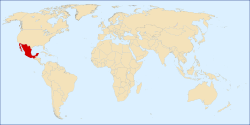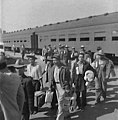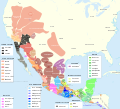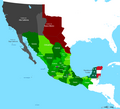Portal:Mexico
|
The Temple of Warriors at Chichen Itza, Mexico
¡Bienvenido! Welcome to the Mexico portal
Mexico, officially the United Mexican States, is a country in the southern portion of North America. It covers 1,972,550 km2 (761,610 sq mi), making it the world's 13th-largest country by area; with a population of almost 130 million, it is the 10th-most-populous country and the most populous Spanish-speaking country. Mexico is organized as a federal constitutional republic comprising 31 states and Mexico City, its capital. It shares land borders with the United States to the north, with Guatemala and Belize to the southeast; as well as maritime borders with the Pacific Ocean to the west, the Caribbean Sea to the southeast, and the Gulf of Mexico to the east.
This is a Featured article, which represents some of the best content on English Wikipedia.
 The Battle of Lipantitlán, also known as the Battle of Nueces Crossing, was fought along the Nueces River on November 4, 1835 between the Mexican Army and Texian insurgents, as part of the Texas Revolution. After the Texian victory at the Battle of Goliad, only two Mexican garrisons remained in Texas, Fort Lipantitlán near San Patricio and the Alamo Mission at San Antonio de Béxar (modern-day San Antonio in the U.S. state of Texas). Fearing that Lipantitlán could be used as a base for the Mexican army to retake Goliad and angry that two of his men were imprisoned there, Texian commander Philip Dimmitt ordered his adjutant, Captain Ira Westover, to capture the fort. The commander of Fort Lipantitlán, Nicolás Rodríguez, had been ordered to harass the Texian troops at Goliad. Rodríguez took the bulk of his men on an expedition; while they were gone, Westover's force arrived in San Patricio. On November 3, a local man persuaded the Mexican garrison to surrender, and the following day the Texians dismantled the fort. Rodríguez returned as the Texians were crossing the swollen Nueces River to return to Goliad. The Mexican soldiers attacked. After a short period, the Mexicans retreated. One Texian was injured, 3–5 Mexican soldiers were killed, and 14–17 were wounded. (Full article...)Selected article - Traditional fixed markets in Mexico are multiple-vendor markets permanently housed in a fixed location. They go by a variety of names such as "mercados públicos" (public markets), "mercados municipales" (municipal markets) or even more often simply "mercados" (markets). These markets are distinct from others in that they are almost always housed in buildings owned and operated by the local government, with numerous stands inside rented by individual merchants, who usually sell, produce and other basic food staples. This market developed in Mexico as a way to regulate pre Hispanic markets called tianguis. These tianguis markets remain in Mexico, with the most traditional held on certain days, put up and taken down the same day, much the way it was done in Mesoamerica. These fixed mercados can be found in any town of any size in Mexico. Often, they are accompanied one or more days per week by tianguis, which set up around the main building. However, the largest, best developed and most numerous fixed markets are in Mexico City, which has over 300, 80 of which are specialty markets dedicated to one or more classes of merchandise, such as gourmet food, plants, cut flowers, candy etc. (Full article...)Selected pictureThis is a Good article, an article that meets a core set of high editorial standards.
On 16 June 2001, Mexico played Costa Rica in a football match at the Estadio Azteca in Mexico City, Mexico on the fourth matchday of the final round in the qualification process for the 2002 FIFA World Cup. Mexico and Costa Rica reached the matchday with four points, both losing as visitors against the United States. Arnoldo Rivera in La Nación described the match as "crucial" as lackluster results by both teams raised doubts prior to the match. The match ended in an unprecedented loss by Mexico. The Mexicans led 1–0 at half-time, with a header by José Manuel Abundis. Costa Rica then made a comeback in the second half, with goals by Rolando Fonseca and Hernán Medford, ending the match 1–2. (Full article...)Selected biography -Juana Inés de Asbaje y Ramírez de Santillana, better known as Sor Juana Inés de la Cruz OSH (12 November 1648 – 17 April 1695), was a colonial Mexican writer, philosopher, composer and poet of the Baroque period, as well as a Hieronymite nun, nicknamed "The Tenth Muse" and "The Phoenix of America" by her contemporary critics. As a Spanish-criolla from the New Spain, she was among the main American-born contributors to the Spanish Golden Age, alongside Juan Ruiz de Alarcón and Garcilaso de la Vega "el Inca", and is presently considered one of the most important female authors in Spanish language literature and the literature of Mexico. Throughout history Sor Juana's significance to different communities has varied significantly, having been presented as a candidate for Catholic sainthood, a symbol of Mexican nationalism, freedom of speech, women's rights, sexual diversity, and others, making her a figure of great controversy and debate to this day. (Full article...)
In the news
Selected fare or cuisine -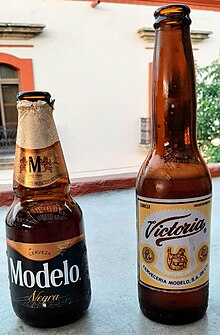 History of beer in Mexico dates from the Spanish conquest of the Aztec Empire. While Mesoamerican cultures knew of fermented alcoholic beverages, including a corn beer, long before the 16th century, European style beer brewed with barley was introduced with the Spanish invasion soon after Hernán Cortés's arrival. Production of this beer here was limited during the colonial period due to the lack of materials and severe restrictions and taxes placed on the product by Spanish authorities. After the Mexican War of Independence, these restrictions disappeared, and the industry was permitted to develop. Furthermore, the arrival of German immigrants during the ephemeral Second Mexican Empire of elected Maximilian I of Mexico, born an Austrian archduke, in the 19th century provided the impetus for the opening of many breweries in various parts of the country. By 1918, there were 36 brewing companies, but over the 20th century, the industry consolidated until today, only two corporations, Grupo Modelo (now owned by AB InBev) and Cervecería Cuauhtémoc Moctezuma formerly known as FEMSA Cerveza (now owned by Heineken N.V.) control 90% of the Mexican beer market. This industry is one of the most prevalent in the country, with over 63% of the population buying one brand or another. Beer is also a major export for the country, with most going to the United States, but is available in over 150 countries worldwide. In 2022, Mexico was the largest beer exporter in the world. (Full article...)
General imagesThe following are images from various Mexico-related articles on Wikipedia.
CategoriesTopicsRelated portalsWikiProjectYou are invited to participate in WikiProject Mexico, a WikiProject dedicated to developing and improving articles about Mexico. Associated WikimediaMore portals | ||||||||||




